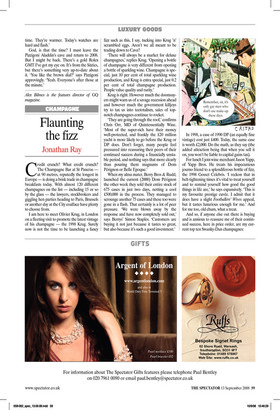Time is of the essence
Alex Bilmes says vintage watches have come of age Deep under the Royal Arcade in Mayfair, in a tiny room reached by a death-trap staircase, I’m holding a pretty but, to the untrained eye, rather unremarkable old stainless-steel wristwatch. It’s very nice, as wristwatches go. But it’s not especially flash. It doesn’t have whiz-bang techie features. It can’t tell you the time in Tokyo and New York simultaneously. It’s not diamond-studded. There’s none of that business with the moon becoming fuller as the month develops. It doesn’t even display the date. Granted, it’s a bit bigger than your average timepiece, but not by much.
Having said all that, it’s a Rolex, and you don’t have to be an accomplished horologist to know that that means big bucks and terrific snob value. Still, ‘If you didn’t know it,’ concedes its owner, Danny Pizzigoni of Royal Arcade Watches, ‘it could just be your bog standard, fifteen-hundred-quid Rolex.’ But it isn’t. It’s a late Sixties model Rolex Milgauss. Notice the little red arrow at the tip of the second hand. See how the minute and hour hands are slightly fatter than on other Rolexes. ‘It’s subtle,’ says Pizzigoni. ‘It’s stealth wealth.’ And it’s yours for upwards of £30,000. A solid investment, according to Pizzigoni, in an item far too rare to be affected by Mr Darling’s nosediving economy. If you can afford it, and you keep it ‘mint’ — in other words, don’t wear it — you can expect its value slowly to increase over the years.
What is it about the Milgauss that makes it special? ‘The most sought-after vintage watches are those that were unpopular at the time they were first on sale, because fewer were made,’ explains Pizzigoni. ‘The Milgauss was designed for people working in areas with high magnetic energy — scientists, maybe. It has an iron inner case, which is why it’s so heavy. And why it was so expensive for the time.’ Now, because the proportions of fashionable watches have increased since the Sixties, resulting in the gigantic sparklers on sale round the corner at Watches of Switzerland, the Milgauss’s time has come again. For those who already own the Belgravia townhouse, the contemporary art collecting second wife and the Rolls-Royce Phantom, it almost qualifies as a must-have.
But you don’t have to be mates with Arki Busson (he’s got a Milgauss) to afford one of Pizzigoni’s watches. Danny will sell you a lovely everyday Rolex Datejust for around £2,000. It gets better: even at the cheaper end of the market, which includes watches you might actually wear, you can expect the timepieces on sale at his shop to hold their value.
The robust health of the vintage watch market is reflected in Pizzigoni’s ambitious plans for his business. A youthful 37, he opened Royal Arcade Watches — soon to be renamed Watchclub London, and to expand into the premises next door — in 1996, after a youth spent trawling the markets of Bermondsey, Portobello and Camden Passage with the encouragement of his dad, legendary watchman Giuseppe. In those years he was mixing with the likes of Paul the Bag, Chop Chop and Siggy: formidable fellows, by Pizzigoni’s accounts, sharp to spot emerging markets for old watches in Japan (they like them small), Germany (they like them militaristic) and Italy (they just like them).
These days Pizzigoni deals with rock aristos (Paul McCartney, Charlie Watts), supermodels (Claudia Schiffer, Elle Macpherson) and hedge-fund managers. The time Giuseppe remembers, when a vintage Rolex Daytona ‘Paul Newman’ with box and papers could sit unwanted in a Hatton Garden window for six months, priced at £400, have gone. The market has matured. In 2008 that same watch, one of which Pizzigoni shows me, might fetch upwards of £100,000.
To Pizzigoni, a real vintage watch — rather than a pre-owned (secondhand is a confusing term when discussing old watches, for obvious reasons) — must be a discontinued model more than 15 years old. To be really valuable, the dial, hands, strap and glass must be original, the watch unpolished, and any fading must be uniform. Pizzigoni sells IWC, Patek Philippe and Cartier, among others, and he also shows me fine examples of Panerai and Audemars Piguet. But it’s Rolex that is his enduring love. He has 75 of his own, and he recommends the brand to anyone looking for an old watch. ‘You won’t go wrong with any of the sports models: Daytona, Submariner, GMT.’ He’s not the only man to talk to. Pizzigoni, though it pains him a little to do so, also recommends his Mayfair competitor David Duggan, and friends who know their Vacheron Constantin from their JaegerLeCoultre also speak highly of Tom Bolt.
‘A watch is often the only accessory a man wears,’ says Pizzigoni. ‘Apart from houses and cars, they’re one of the only ways for us to show off our taste.’ And a vintage watch demonstrates flair. ‘They’re more individual. There’s a story to them.’ And Pizzigoni detects a softer, more genteel charm to vintage watches. ‘They’re from a more gentle time. They’re warmer. Today’s watches are hard and flash.’ God, is that the time? I must leave the Pizzigoni Aladdin’s cave and return to 2008. But I might be back. There’s a gold Rolex GMT I’ve got my eye on. It’s from the Sixties, but there’s something very up-to-date about it. ‘You like the brown dial?’ says Pizzigoni approvingly. ‘Yeah. Everyone’s after those at the minute.’











































































 Previous page
Previous page